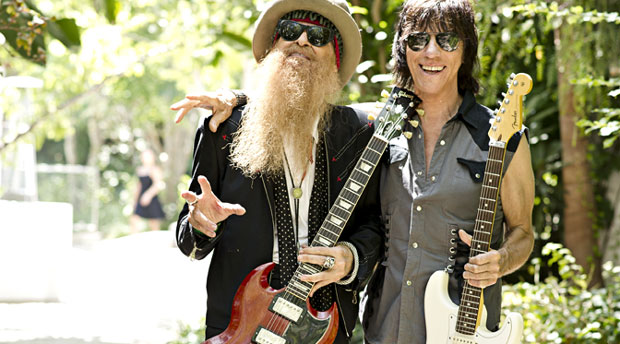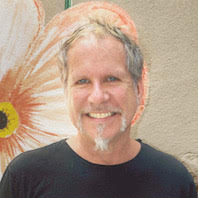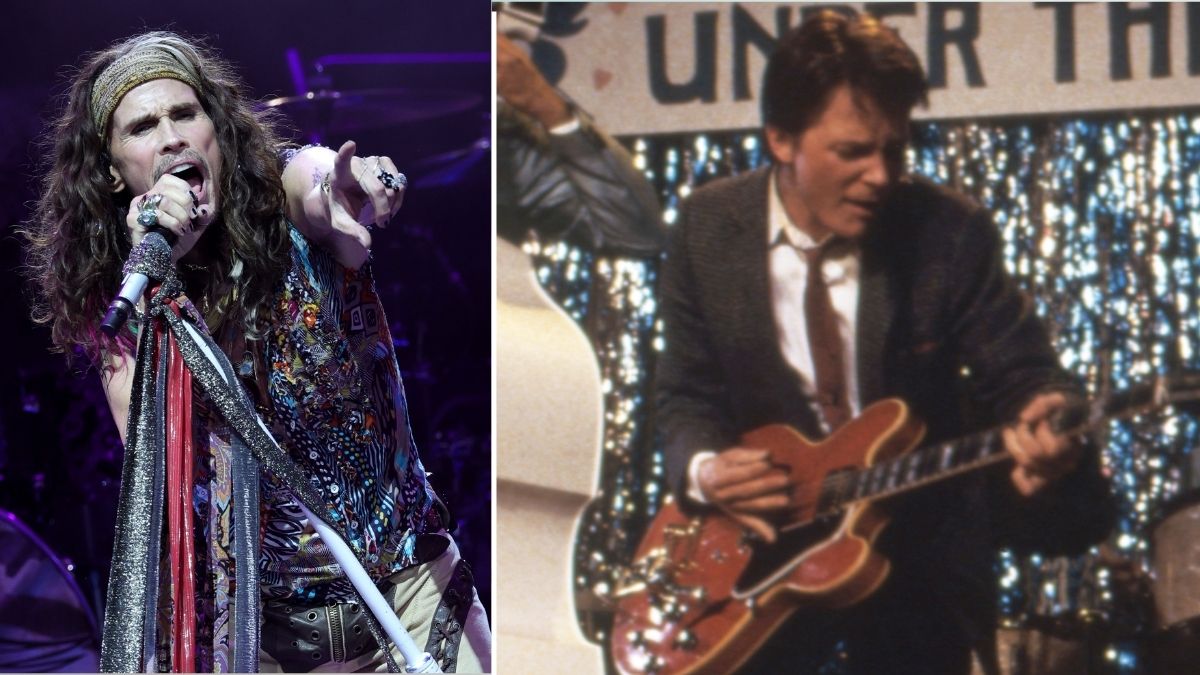Jeff Beck and ZZ Top’s Billy Gibbons Discuss the Rocking Relationship Between Guitars, Cars and Everything in Between

This is an excerpt from the all-new November 2014 issue of Guitar World. For the rest of this story, plus new Gibbons/Beck photos by Ross Halfin, not to mention features on Weezer, George Thorogood, MXR & Eddie Van Halen, the guitar pick revolution, Nita Strauss and Black Veil Brides, plus gear reviews (Epiphone, Zoom, Gretsch, TC-Helicon, Mesa and more) and lessons by Marty Friedman and Steel Panther's Satchel, check out the November 2014 issue of Guitar World!
The Surreal Thing: As they prepare to hit the road together for a summer tour, Jeff Beck and ZZ Top’s Billy Gibbons wax philosophical on the rock and roll relationship between guitars, cars and everything in between.
It’s a hot, sunny California day as Jeff Beck and ZZ Top’s Billy F. Gibbons stroll through the lush courtyard of Hollywood’s swanky Sunset Marquis Hotel.
Ripe for caricature, they are perhaps two of the most distinctive-looking performers in rock history. Beck, with his much-imitated rooster shag haircut, and Gibbons, dressed in full hipster Wild West drag, look almost disconcertingly the same as they have for the past three or four decades.
If we hadn’t invited them ourselves on the eve of their first tour together, it would be easy to mistake them for a mirage from one of those surreal ZZ Top videos that dominated MTV in the Eighties.
Surreal is actually a word that pops up quite often in conversations with both musicians over the next few days. It’s certainly a fitting adjective to describe aspects of their music.
Since Beck’s stunning 1965 debut with the Yardbirds, he has thrilled and confounded guitarists with his exciting and often avant-garde approach to the instrument. His playful and imaginative take on Willie Dixon’s “Ain’t Superstitious” from Truth, his 1968 album with Rod Stewart on vocals and Ronnie Wood on bass, certainly rivaled anything Jimi Hendrix was creating at the time.
All the latest guitar news, interviews, lessons, reviews, deals and more, direct to your inbox!
And his consistently innovative work on tracks like “Going Down” (1972), “Blue Wind” (1976),” “Where Were You” (1989) and “Hammerhead” (2010), which won a Grammy Award for Best Rock Instrumental Performance, continues to push the limits of what can be done on a Fender Stratocaster without getting arrested.
And anyone with even a passing knowledge of ZZ Top knows how strange they can be. Comprised of Gibbons, bassist Dusty Hill and drummer Frank Beard, the Little Ol’ Band from Texas has defied any civilized notion of what traditional rock musicians should look and sound like. Yet, their wonderfully skewed take on the blues has helped them sell somewhere in the neighborhood of 50 million albums, and they continue to play the world’s biggest concert halls.
Gibbons, in his inimitable deep Texas drawl, concurs that surreal is indeed the word of the day. “One of the highest compliments that ever came my way was sent from [guitarist] Jimmie Vaughan,” he says, chuckling. “He said, ‘Oh yeah, Gibbons is out there.’ But if there’s actually an ‘out there,’ guess what? We’ll go out there and find Jeff Beck!”
GUITAR WORLD: Billy, what does Jeff Beck mean to you? What is his importance as an artist?
BILLY GIBBONS Before Jeff and ZZ Top embarked on this tour, I received a phone call from the production office asking about design preferences for our backstage passes. The reply was simple: “Well, there’s a juicy guitar image fitting to go on the ZZ side of the pass, and there awaits a superb geetar view for Jeff’s side as well.”
On one side, we chose a view of the infamous, Pearly Gates, my fine ’59 Les Paul ’Burst, and on the other side, we landed an image of Jeff’s magnificently battle-scarred 1954 Fender Esquire used with the Yardbirds. When you’re using the word importance, one can easily find it in the guitars that Jeff Beck and I pounded the sides off long ago. Jeff’s guitar certainly stands as a pivotal piece, marking the point where bravery stepped in with a willingness to experiment, moving the six-string expression far outside any previously proven lines. The visual impact of that beat-up war club is still meaningful and forceful to the extreme.
Jeff, what do you find cool about Billy and ZZ Top?
JEFF BECK Just think about how people went for Billy’s sound and the band’s image. ZZ Top went completely against the grain of all one would expect iconic rock to be. That’s what I love about them—they are this wonderful quirky backfire. Billy’s tone is great, and so are his songs. You wouldn’t really expect these bearded guys to write all these great tunes about cars and girls.
Both you and Jeff introduced a surrealistic element into the blues. In Jeff’s case, his versions of “I Ain’t Superstitious” and “Going Down” wink at traditionalism. ZZ Top often references the blues, but they also have a little irreverent fun with the genre. How important is it for you to let your audience know that you are self-aware? You know: “I’m not from the Delta, but I still love this music and there’s a way to modernize it.”
BECK When you are taken with any music with inner gusto, you don’t think too much about it—you just have to have it!
- For example, I was playing in a blues band before I joined the Yardbirds, and I was really into Bo Diddley, who made the best use imaginable out of playing one chord. His outrageous jungle rhythms were so powerful and hypnotic, he didn’t have to change keys. We basically took his idea of the one-chord vamp, and while the band played, I would just slack all my strings and then really pull on them to make the most ridiculous and surreal sounds with slap echo so that people would just look up.
- It wasn’t premeditated.
I just wanted the audience to look at me and listen! I did all kinds of outrageous things like that at the time, like taking two guitars and have them feedback against each other, and it was that kind of attitude that eventually got me the job with the Yardbirds. They didn’t want someone to play a beautiful slide guitar solo, or someone that sounded like Earl Hooker.
They wanted someone that would hold an audience. I had something no one else had, and however crude or outrageous it was at the time, it worked. It wasn’t all that calculated. It was just my way of saying, Here I am. Ultimately, I had to tone some of it down when I joined the Yardbirds, because we were going on television playing pop singles.
Billy, how important is it for you to add a little touch of the “untraditional” to your traditional blues?
GIBBONS This position was being prodded in a discussion in Memphis, Tennessee, with a dear friend, Waltaire Baldwin. We came up together in Houston and kept our friendship for a long time. Waltaire is a poet. Gave me a John Lee Hooker disc when we were 12 and then showed me how to draw blues harmonica.
Waltaire and I were in deep contemplation at 89 Union Street Saloon, sitting atop a table right near the corner window, overlooking the Mississippi. We both agreed that although we never picked cotton, didn’t grow up on plantation, it did not necessarily prevent creating an honest attempt making the truth of the blues a backbone of interpretation. The one ZZ tune that really captures this thought is, “My Head’s in Mississippi.”
Although it ain’t the Thirties, all that hard-rhythm shuffle boogie coupled with a surrealistic Howlin’ Wolf’s delivery creates a subdued assembly of visual pictures. The great Memphis guitarist and producer Jim Dickinson once remarked, “Oh yeah, you guys are doing what I like. You’ve become a Salvador Dali—the Dali of the Delta.” Once you get that far along, the point’s made!
What is the cosmic connection between the appreciation of an automobile and a guitar?
GIBBONS It’s a big question, but a good one! What’s really the wicked connection is that they can be loud and fast; yet, they can also be quite elegant. While I was in Spain visiting Nacho Baños, the noted authority on early Fifties blackguard Fenders, we spent more than a day and a night—make it days and nights—talking about automotive elegance and the connection with the unchanged beauty of that original Fender. Call it the Telecaster, the Esquire, the Broadcaster or call it the No-caster—it’s become one of those timeless things.
BECK Guitars and cars offer experiences that are both quite amazing. The other day I was thinking, Why are there so many people in cars? It’s because it’s such a pleasure to have that experience, regardless of where you are going. It’s almost habit forming. You want to control your movement, but at the same time your brain is going at an unnatural speed and you’re putting yourself in danger.
There’s that element of excitement every time you turn the ignition. It’s not that you’re just driving from point A to B—you’re enjoying every second of being in control of your life…or avoiding death! Listening to great rock and roll music also gives you this exhilarating sense of awareness similar to what you have when you are driving.
There are other more obvious connections. Hot rods are cool looking and rock and roll is cool looking, and they both came of age at the same time in the Fifties. If America never created anything else, thank you very much for the hot rods and rock and roll!
This is an excerpt from the all-new November 2014 issue of Guitar World. For the rest of this story, plus new Gibbons/Beck photos by Ross Halfin, not to mention features on Weezer, George Thorogood, MXR & Eddie Van Halen, the guitar pick revolution, Nita Strauss and Black Veil Brides, plus gear reviews (Epiphone, Zoom, Gretsch, TC-Helicon, Mesa and more) and lessons by Marty Friedman and Steel Panther's Satchel, check out the November 2014 issue of Guitar World!
Photo: Ross Halfin
A long time ago in a galaxy far, far away Brad was the editor of Guitar World from 1990 to 2015. Since his departure he has authored Eruption: Conversations with Eddie Van Halen, Light & Shade: Conversations with Jimmy Page and Play it Loud: An Epic History of the Style, Sound & Revolution of the Electric Guitar, which was the inspiration for the Play It Loud exhibition at the Metropolitan Museum of Art in New York City in 2019.

